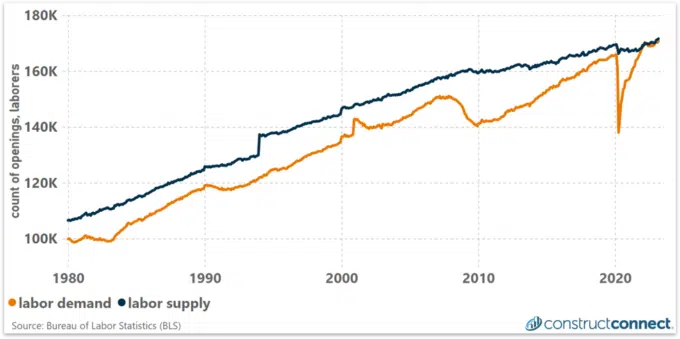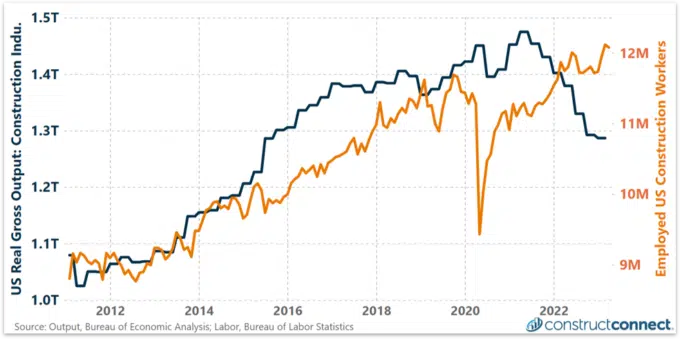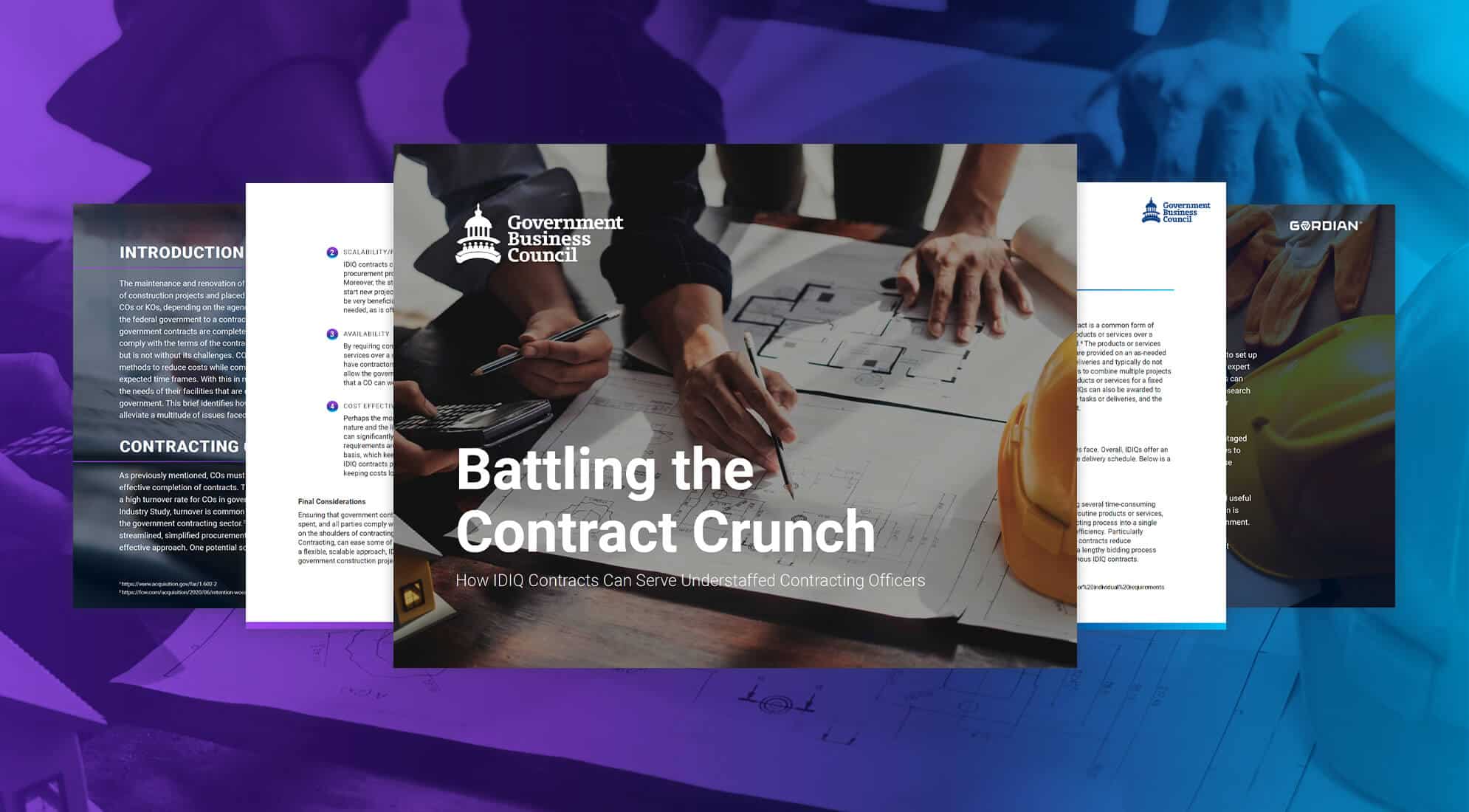Many corners of the construction industry are experiencing extreme issues with hiring and retaining staff, and federal groups are among those areas affected. Fewer qualified applicants, a wave of recent retirements and a high level of turnover have formed the ideal conditions for a storm of skilled labor shortages.
The below diagram, discussed by experts from Gordian and Construct Connect on a recent construction cost trends webinar, shows how the gap between construction-related labor supply and demand has never been tighter than now. More than ever, there are too few available laborers to meet the growing demand of construction services across public and private industries.
Segmenting the labor force by age group adds context to the overall story. While COVID immediately diminished the total labor force, much of the talent aged 55 and over have not returned to work. However, available talent between the ages of 25 and 34 has continued to grow considerably since 2020, surpassing the number of workers aged 55 and over.
This means that, while labor is already in high demand and relatively low supply, the average worker is likely to be younger and have less career experience than before. In simpler terms, the rapid retirement of longtime workers has created a lack of expertise in key positions.
A downstream effect of this reduction in skilled talent is the decreased productivity in the construction industry. In essence, the increase in key positions filled by less seasoned staff with fewer years of experience and training is slowing down the efficiency of construction work, causing more time to be spent on tasks that might be considered routine for previous position-holders. As can be observed in the above graph, the compounding effect of this phenomenon has resulted in a sharp drop in the inflation-adjusted gross output of the construction industry over the last two years despite a growing workforce.
The Problem: Spending Too Much Time Per Contract
All of this data shows that the real issue amid the current labor shortage might not actually be the lack of available labor, but rather the decline in the skill level of the available workforce. To more closely examine the effects of the current construction labor market, we’ll hone in on federal contracting offices.
Contracting offices historically have a high level of turnover, with staff passing through for several months or years on their way to other assignments. Additionally, they often carry a large workload, juggling hundreds to thousands of contracts in a condensed fiscal year – many of which pile up near fiscal year end as remaining funds are allocated expressly.
With fewer expert staff to manage contracts amid these labor conditions, contracting offices are stuck between the rock of approving fewer contracts, which can negatively impact mission readiness, and the hard place of accumulating large backlogs. There is, however, a third option that can help stave off some portion of the backlog while meeting Federal Acquisition Regulation (FAR) requirements and maintaining the guarantee of fair and reasonable pricing. That third route is increased contract efficiency.
One way to measure this effect in contracting offices is by analyzing work hours per purchase order. That is, how much time was spent researching, reviewing and approving a contract before it can be utilized. Assuming that the number of contracts moving through a respective office does not decrease year-over-year, understaffed offices need to decrease the average time spent on each contract or else risk an ever-growing backlog.
Often, the contracts that KOs manage are one-to-one contracts, meaning only one project or purchase order is covered by the contract. One-to-one contracts are essential for high-dollar and complex projects that require more attention to detail, greater design work or are unlikely to be repeated in the near future. Such contracts, though, increase the average administrative time spent per contract, as the contract is limited to one execution phase.
By moving toward umbrella contracts and indefinite delivery, indefinite quantity contracts (IDIQs), which allow for multiple projects to be issued through a single procurement cycle, offices can bring down the overall work hours per contract rate. This can help maintain mission readiness even during staff shortages.
Gordian recently partnered with Government Business Council to create an introductory report on IDIQs for federal and military KOs. Download it here to learn about the benefits IDIQ project delivery brings to contracting offices.
The Solution: Using IDIQs to Procure More Work in Less Time
IDIQs are ideal for types of work that will be repeated frequently or require little to no design work. And while they can be used for larger projects, they have their limitations for heavy design work. Even within the world of IDIQ project delivery, different contract types have distinct advantages and use cases.
IDIQs tend to fall into two categories: single-award IDIQs and multiple-award IDIQs. As the categories suggest, single-award IDIQs enable a single contractor to provide services to the owner, whereas multiple-award contracts pre-qualify a small group of contractors to provide services.
Once a project is identified, contractors under a single-award contract can immediately begin scoping the project and drawing up designs or, if design work isn’t needed, jump right into starting the project work. Contractors under multiple-award contracts, on the other hand, will often need to go through a second round of bidding before they can begin work. This means, when looking through the lens of work hours per purchase order, single-award IDIQs, like single-award task order contracts (SATOC), Job Order Contracting (JOC) and simplified acquisition of base engineer requirements (SABER), reduce work hours per purchase order further than multiple-award IDIQs.
Bonus: Using IDIQ Project Delivery to Increase SDB Opportunities
Both single-award and multiple-award IDIQ contracts are growing in popularity. Along with sole sourcing, they are one of the most efficient ways to procure construction and renovation services. Additionally, they enable federal owners to provide small and disadvantaged businesses with work opportunities that they may not be able to bid on through more traditional contract methods.
As contracting offices continue to battle ongoing staffing shortages, they should explore IDIQ project delivery as a way to increase efficiency without risking mission readiness, perhaps even examining whether lines of work previously held under other contract methods could be held under IDIQs moving forward. For over 30 years, Gordian has been coordinating federal JOC programs as an extension of contracting offices’ staff teams. We can help your office meet its goals and complete more mission-critical projects.









